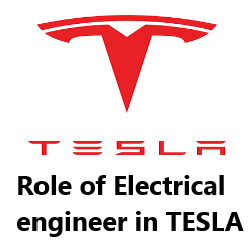
Role of Electrical engineer in Tesla Company
Electrical engineers play a crucial role at Tesla, contributing to the design, development, and optimization of cutting-edge electric vehicles (EVs), energy storage systems, and renewable energy solutions. Also including vehicle design, battery systems, energy products (like Powerwall and Solar Roof), and manufacturing automation.
Electric Vehicle (EV) Development
Electrical engineers work on high-efficiency electric motors, inverters, and power electronics to improve performance, efficiency, and reliability.
They design and optimize battery management systems (BMS) for Tesla’s lithium-ion batteries, ensuring safety, longevity, and fast charging.
Developing silicon carbide (SiC)-based inverters and converters to enhance energy efficiency in Tesla’s drivetrains.
Battery Systems
Design and development of battery packs for vehicles like the Model S, Model 3, and Cybertruck.
Work on Battery Management Systems (BMS) that monitor cell voltages, temperatures, and state of charge.
Develop high-voltage components, inverters, DC-DC converters, and charging systems.
Energy Products (Tesla Energy)
Engineers work on Powerwall and Megapack battery systems, optimizing grid storage and renewable energy integration.
Design inverters, solar inverters, and grid-interactive technologies.
Help in developing smart grid and energy storage systems.
Autonomous & Embedded Systems
Electrical engineers contribute to sensor integration (cameras, radar, ultrasonic), neural network accelerators, and real-time control systems for autonomous driving.
Designing embedded systems for vehicle control, infotainment, and connectivity.
Develop low-level firmware for microcontrollers and embedded processors.
Collaborate with software teams to ensure hardware-software integration is seamless.
Vehicle Electrical Architecture
Design and optimize the wiring harnesses, controllers, and embedded systems used in Tesla vehicles.
Collaborate on Autopilot hardware, sensor integration, and infotainment systems.
Ensure electromagnetic compatibility (EMC) and safety compliance.
Engineers enhance Supercharger V4 systems for ultra-fast charging while maintaining battery health.
Ensuring compatibility with different power grids and renewable energy sources.
Manufacturing & Automation
Develop and support automated manufacturing equipment, robots, and control systems.
Work on programmable logic controllers (PLCs) and industrial electrical systems.
Implement systems to improve production efficiency and reliability.
Innovation & Future Technologies
Researching 4680 battery cells, solid-state batteries, and advanced thermal management.
Integrating AI for predictive maintenance, energy optimization, and autonomous driving.
Wireless Charging & Vehicle-to-Grid (V2G) Tech
Electrical engineer work on researching inductive (wireless) charging for future Tesla models.
Enabling bidirectional power flow (Cybertruck can power homes via V2G).
Energy Grid Stabilization
Engineers enable Tesla Powerwalls to form grid-scale virtual power plants (VPPs).
Algorithms dynamically adjust energy discharge during peak demand.
Skills Required for Tesla Electrical Engineers
Circuit design (analog and digital)
Power electronics
Control systems
Embedded systems & firmware development (C/C++, Python)
Battery & energy storage technologies
CAD tools (SPICE, Altium, MATLAB/Simulink)
Knowledge of automotive standards (ISO 26262, ASPICE)
Strong problem-solving and cross-functional collaboration skills
